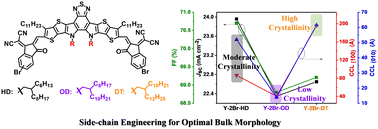Optimal bulk morphology via side-chain engineering on non-fullerene acceptor for efficient organic solar cells†
Abstract
Molecular self-assembly is a key factor that significantly influences the bulk film morphology to achieve the desired optoelectronic properties in organic photovoltaic devices. However, controlling the molecular aggregation and crystallinity via molecular design to reach the optimal bulk film morphology remains challenging. Herein, we designed and synthesized three non-fullerene acceptors (NFAs) referred to as Y-2Br-R (with R being the branched alkyl chain) using the same central core with Y6 but with different sizes of branched alkyl chains on the pyrrole motif. Comparative studies show that engineering the N-alkyl chains onto the Y-2Br-R NFAs has a negligible effect on their energy levels. However, a significant impact on the molecular aggregation and crystallinity of the three NFAs was recorded, which allowed further manipulation of the donor and acceptor intermixing and resulted in different bulk film morphology. Specifically, the Y-2Br-HD-based bulk film shows a distinctly fibrous nanostructure with a favorably vertical composition distribution for efficient charge dissociation and transport. As a result, the Y-2Br-HD-based devices achieved a higher power conversion efficiency of 15.32% with a comparable short-circuit current density of 23.96 mA cm−2 and a fill factor of 70.7%, outperforming the other devices. Our study provides a new perspective for understanding the relationships between side-chain modification-refined bulk film morphology and optoelectronic properties to develop high-performance NFAs.



 Please wait while we load your content...
Please wait while we load your content...